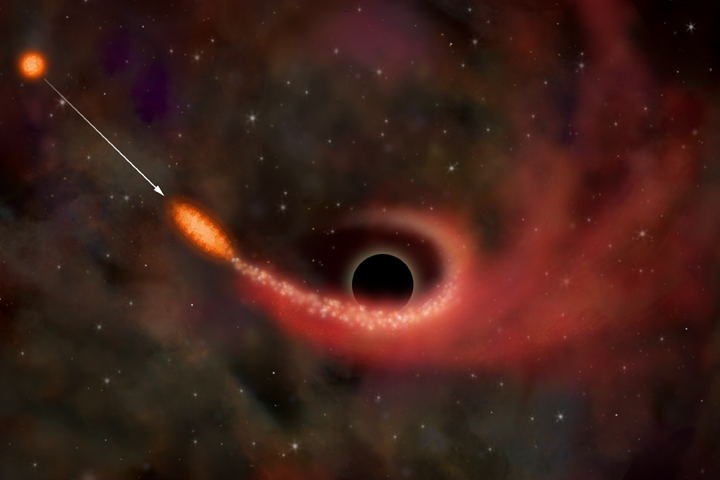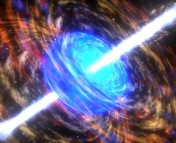• Title: Dissipation Efficiency of Reconfinement Shocks in Relativistic Jets
• Author: Krzysztof Nalewajko
• Author’s Institution: JILA (U. Colorado and NIST) and Nicolaus Copernicus Astronomical Centre, Poland

Figure 1: Artist's conception of a blazar jet (as viewed from the side). Image credit: Marscher et al., Wolfgang Steffen, Cosmovision, NRAO/AUI/NSF
Introduction
Two of the brightest phenomena in the Universe, namely gamma-ray bursts (GRBs; see these astrobites) and blazars (active galactic nuclei with jets pointed toward us; see this astrobite and the glossary), are both thought to be powered by relativistic jets. We know that relativistic Doppler-beaming of the radiation toward us helps to explain the enormous luminosities observed (GRBs clock in at up to ~1053 erg/s, blazars at up to ~1050 erg/s), but even accounting for this, the jets must be radiating huge amounts of energy. A relativistic jet inherently has a great deal of kinetic energy, so the relevant question is: how does this get turned into radiation?
Somewhere, the jet’s kinetic energy must be dissipated. There are three likely culprits: shock waves, magnetic reconnection, and instabilities. Shocks form when one fluid plows into another quickly enough that there’s no time for the second fluid to get out of the way (an example of this occurs when a gun is fired). Magnetic reconnection occurs when magnetic field lines break and reform in a lower-energy configuration, thus releasing energy (such as when a coronal loop pinches off and forms a solar flare, as shown in this clip). Instabilities arise, as an example, at interfaces between the jet and environment around it (like the Kelvin-Helmholtz instability, pictured here, which occurs between two fluids of different velocities). In this paper, the author focuses on the first of these explanations, and examines the energy dissipation that occurs as a result of reconfinement shocks.
The Model
Reconfinement shocks are shocks that occur as a result of the jet plowing into the environment around it and being forced to re-close by the pressure of that environment (see Figure 2). The question the author seeks to address is whether a reconfinement shock could dissipate enough energy to explain the jet luminosities that we observe.

Figure 2: A slice of the jet, which is cylindrically symmetric about the z-axis and propagates from z=0 until the external pressure forces it closed again at z=z_r. Fig. 1 from the paper.
Using the equations that describe how a fluid behaves when it crosses a shock front, the author obtains an expression for the energy dissipation efficiency in terms of the pressure of the external environment, the jet’s opening and closing angles (Θj , Θr ), and the jet’s speed, which is measured by its Lorentz factor (Γj).
Results
Comparison to blazars
According to the author, observations of AGN jets indicate that they satisfy the relation Γj Θj <~ 1, and that the radiative efficiencies of the brightest blazars are around 10%. The author’s calculations show that, for a product of the jet’s Lorentz factor and its closing angle of less than 1 (Γj Θr < 1), the radiative efficiency of reconfinement shocks is well-described by the expression εdiss = 8% (Γj Θr) 2, regardless of the external pressure. Thus, this model is in keeping with blazar observations.
Comparison to GRBs
GRBs have to break out of a star before they can become free. Once they have done so, however, they are expected to spread out with a wide opening angle such that Γj Θj >> 1. In this limit, the author’s model predicts that the radiative efficiency is roughly 80-90% depending on the external pressure, which consistent with the anticipated efficiencies of nearly 90% based on observations of GRBs.
Conclusion
The author successfully demonstrates that reconfinement shocks in jets allow energy dissipation that is roughly consistent with the observed luminosities of both blazars and gamma-ray bursts. This suggests that they may well be the dominant energy-dissipation mechanism in these phenomena, and certainly deserve further investigation.





Trackbacks/Pingbacks